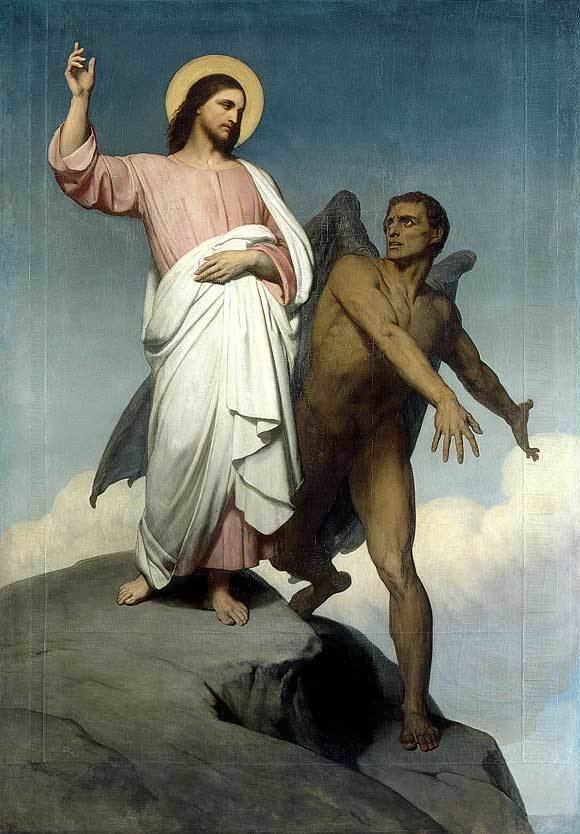 | ||
The temptation of Christ is detailed in the Gospels of Matthew, Mark, and Luke. According to these texts, after being baptized by John the Baptist, Jesus fasted for forty days and nights in the Judaean Desert. During this time, Satan appeared to Jesus and tried to tempt him. Jesus having refused each temptation, the devil then departed and Jesus returned to Galilee.
Contents
- The last temptation of christ 1988 christ and pilate
- Discussion of status as parable
- Use of Old Testament references
- Content of the Matthew and Luke narratives
- 1 Stones into bread
- 2 Pinnacle of the temple
- 3 Mountain
- Ministered to by angels
- Temptations of Christ in Gospel of Mark
- Temptations of Christ in Gospel of John
- Christian interpretations
- The Temptation of Christ in art literature film and music
- References
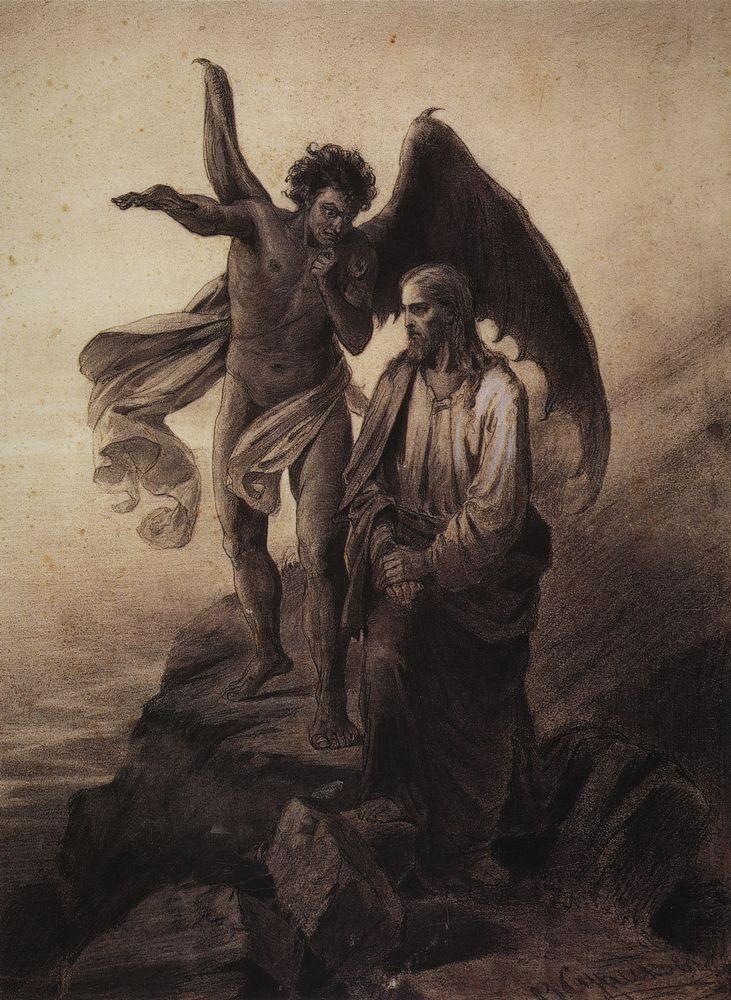
Temptations were hedonism (hunger / satisfaction), egoism (spectacular throw / might) and materialism (kingdoms / wealth). John the Evangelist in his epistle calls these temptations "in world" as "lust of eyes" (materialism), "lust of body" (hedonism) and "pride of life" (egoism). Temptations aim to mislead and pervert three main human characteristics; to think, wish and feel which are inside mind, soul and heart as Jesus alludes in Greatest Commandment. These are related with transcendentals or ultimate ideals in three areas of human interests; science (truth), arts (beauty) and religion (goodness). Christians are called to search for divine virtues; faith, hope and love that relate them directly to God who Himself is Truth, Beauty and Goodness.
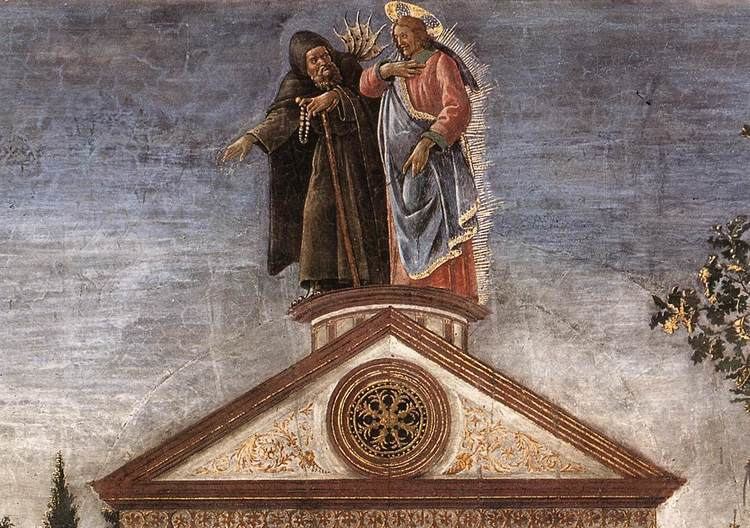
The writer of the Epistle to the Hebrews also refers to Jesus having been tempted "in every way that we [i.e. Christian believers] are".
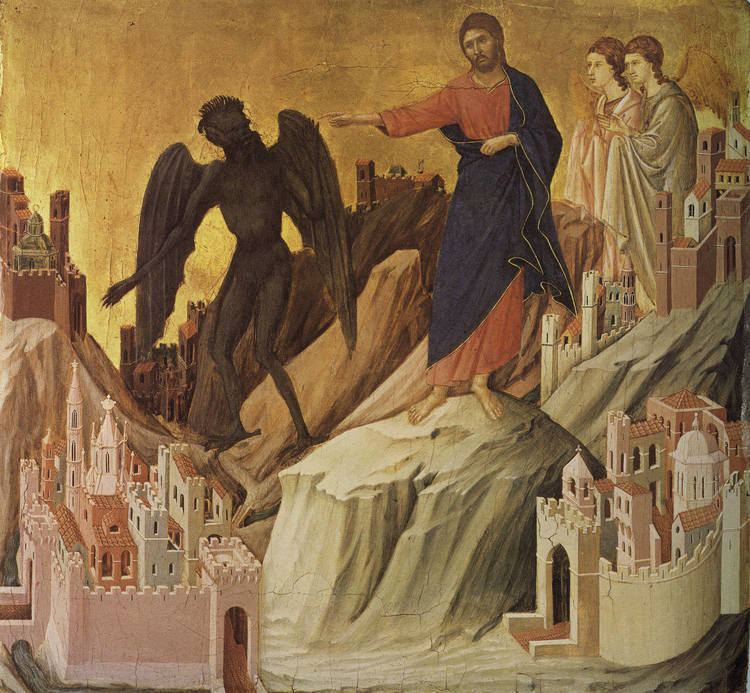
Mark's account is very brief, merely noting the event. Matthew and Luke describe the temptations by recounting the details of the conversations between Jesus and Satan. Since the elements that are in Matthew and Luke but not in Mark are mostly pairs of quotations rather than detailed narration, many scholars believe these extra details originate in the Q Document. The temptation of Christ is not explicitly mentioned in the Gospel of John but in this gospel Jesus does refer to the devil, "the prince of this world", having no power over Him.
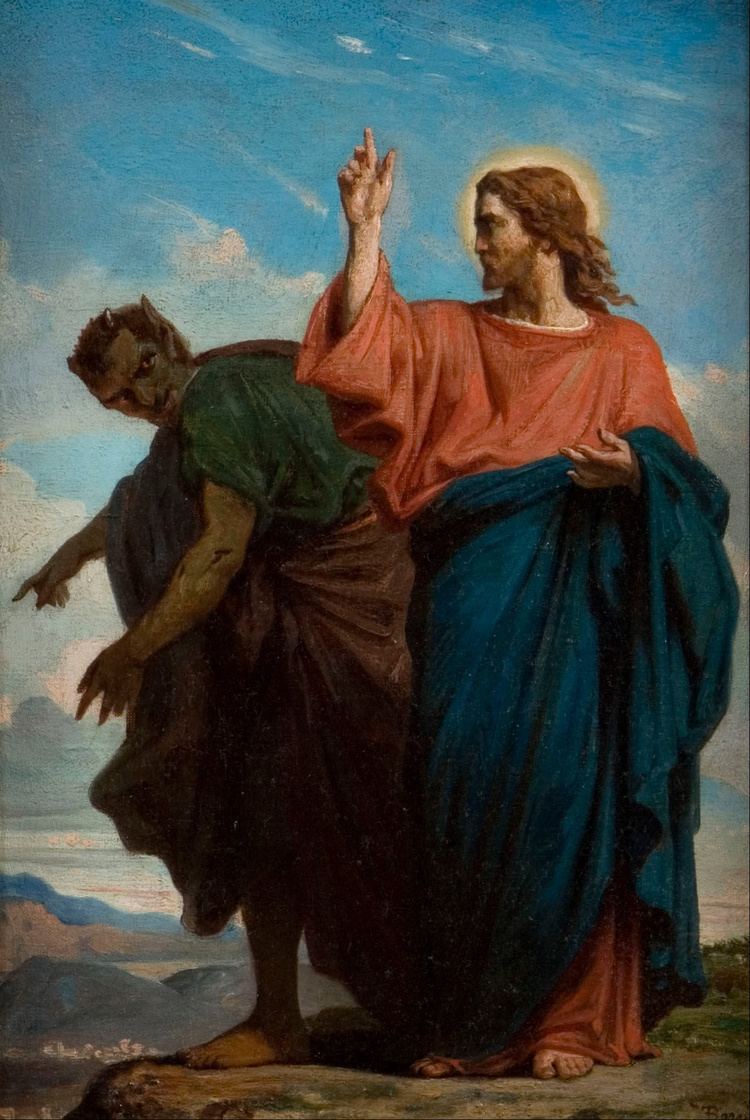
The last temptation of christ 1988 christ and pilate
Discussion of status as parable
Discussion of the literary genre includes whether what is represented is a history, a parable, a myth, or compound of various genres. This relates to the "reality" of the encounter. Sometimes the temptation narrative is taken as a parable, reading that Jesus in his ministry told this narrative to audiences relating his inner experience in the form of a parable. Or it is autobiographical, regarding what sort of Messiah Jesus intended to be. Writers including William Barclay have pointed to the fact that there is "no mountain high enough in all the world to see the whole world" as indication of the non-literal nature of the event, and that the narrative portrays what was going on inside Jesus' mind. Dominican theologian Thomas Aquinas explained, "In regard to the words, 'He showed Him all the kingdoms of the world, and the glory of them,' we are not to understand that He saw the very kingdoms, with the cities and inhabitants, their gold and silver: but that the devil pointed out the quarters in which each kingdom or city lay, and set forth to Him in words their glory and estate."
The debate on the literality of the temptations goes back at least to the discussion of George Benson (d.1762) and Hugh Farmer.
A traditional Catholic understanding is that the temptation of Christ was a literal and physical event. "Despite the difficulties urged, ... against the historical character of the three temptations of Jesus, as recorded by St. Matthew and St. Luke, it is plain that these sacred writers intended to describe an actual and visible approach of Satan, to chronicle an actual shifting of places, etc., and that the traditional view, which maintains the objective nature of Christ's temptations, is the only one meeting all the requirements of the Gospel narrative."
The Catechism of the Catholic Church states:
The Gospels speak of a time of solitude for Jesus in the desert immediately after his baptism by John. Driven by the Spirit into the desert, Jesus remains there for forty days without eating; he lives among wild beasts, and angels minister to him. At the end of this time Satan tempts him three times, seeking to compromise his filial attitude toward God. Jesus rebuffs these attacks, which recapitulate the temptations of Adam in Paradise and of Israel in the desert, and the devil leaves him "until an opportune time". The temptation in the desert shows Jesus, the humble Messiah, who triumphs over Satan by his total adherence to the plan of salvation willed by the Father.
Use of Old Testament references
The account of Matthew uses language from the Old Testament. The imagery would be familiar to Matthew's contemporary readers. In the Septuagint Greek version of Zechariah 3 the name Iesous and term diabolos are identical to the Greek terms of Matthew 4. Matthew presents the three scriptural passages cited by Jesus (Deut 8:3, Deut 6:13, and Deut 6:16) not in their order in the book of Deuteronomy, but in the sequence of the trials of Israel as they wandered in the desert, as recorded in the book of Exodus. Luke's account is similar, though his inversion of the second and third temptations "represents a more natural geographic movement, from the wilderness to the temple". Luke's closing statement that the devil "departed from him until an opportune time" may provide a narrative link to the immediately following attempt at Nazareth to throw Jesus down from a high place, or may anticipate a role for Satan in the Passion (cf. Luke 22:3).
Content of the Matthew and Luke narratives
In Luke's (Luke 4:1–13) and Matthew's (Matthew 4:1–11) accounts, the order of the three temptations, and the timing (within or at the end of the 40 days) differ; no explanation as to why the order differs has been generally accepted. Matthew, Luke and Mark make clear that the Spirit has led Jesus into the desert.
Fasting traditionally presaged a great spiritual struggle. Elijah and Moses in the Old Testament fasted 40 days and nights, and thus Jesus doing the same invites comparison to these events. In Judaism, "the practice of fasting connected the body and its physical needs with less tangible values, such as self-denial, and repentance." At the time, 40 was less a specific number and more a general expression for any large figure. Fasting may not mean a complete abstinence from food; consequently, Jesus may have been surviving on the sparse food that could be obtained in the desert. Although Mark, Matthew, and Luke combine Jesus' fast of forty days with his temptation, other Biblical passages suggest that Jesus' fast was a test to be completed before his encounter with Satan.
Mark does not provide details, but in Matthew and Luke "the tempter" (Greek: ὁ πειραζων, ho peirazōn) or "the devil" (Greek: ὁ διαβολος, ho diabolos) tempts Jesus to:
1. Stones into bread
The temptation of making bread out of stones occurs in the same desert setting where Jesus had been fasting. Alexander Jones reports that the wilderness mentioned here has since the fifth century been believed to be the rocky and uninhabited area between Jerusalem and Jericho, with a spot on Mount Quarantania traditionally being considered the exact location. The desert was seen as outside the bounds of society and as the home of demons such as Azazel (Leviticus 16:10). Gundry states that the desert is likely an allusion to the wilderness through which the Israelites wandered during the Exodus, and more specifically to Moses. Jesus' struggle against hunger in the face of Satan points to his representative role of the Israelites, however he does not fail God in his urge for hunger. This temptation may have been Jesus' last, aiming towards his hunger.
In response to Satan's command, Jesus replies, "It is written: 'One does not live by bread alone, but by every word that proceeds from the mouth of God.'" Only in Matthew is this entire sentence written.
2. Pinnacle of the temple
Most Christians consider that holy city refers unquestionably to Jerusalem and the temple to which the pinnacle belongs is thus identified as the Temple in Jerusalem. Gospel of Matthew refers to "the temple" 17 times without ever adding "in Jerusalem". That Luke's version of the story clearly identifies the location as Jerusalem may be due to Theophilus' unfamiliarity with Judaism.
What is meant by the word traditionally translated as pinnacle is not entirely clear since the Greek diminutive form pterugion ("little wing") is not extant in other architectural contexts. Though the form pterux ("large wing") is used for the point of a building by Pollianus, Schweizer feels that little tower or parapet would be more accurate, and the New Jerusalem Bible does use the translation "parapet". The only surviving Jewish parallel to the temptation uses the standard word šbyt "roof" not "wing": "Our Rabbis related that in the hour when the Messiah shall be revealed he shall come and stand on the roof (šbyt) of the temple." (Peshiqta Rabbati 62 c–d) The term is preserved as "wing" in Syriac translations of the Greek.
Robert H. Gundry (1994) lists three sites at the Jerusalem temple that would fit this description:
"If thou be the Son of God, cast thyself down from hence: For it is written, He shall give his angels charge over thee, to keep thee: And in their hands they shall bear thee up, lest at any time thou dash thy foot against a stone." (Luke 4:9–13) citing Psalms 91:12.
Once more, Jesus maintained his integrity and responded by quoting scripture, saying, "Again it is written, 'You shall not put the Lord, your God, to the test.'" (Matthew 4:7) from Deuteronomy 6:16. –. Jesus implies that God has established man as a worshipper of faith, not in certainty.
3. Mountain
For the final temptation, the devil takes Jesus to a high place, which Matthew explicitly identifies as a very high mountain, where all the kingdoms of the world can be seen. The spot pointed out by tradition as the summit from which Satan offered to Jesus dominion over all earthly kingdoms is the "Quarantania", a limestone peak on the road from Jerusalem to Jericho.
Instead of a literal reading, George Slatyer Barrett viewed the third temptation as inclining to a doubt of Christ's mission, or at least the methodology. Barrett sees this as a temptation to accept the adulation of the crowds, assume leadership of the nation to overthrow Roman rule, take the crown of his own nation, and from there initiate the kingdom of God on earth. The kingdoms Jesus would inherit through Satan are obtained through love of power and political oppression. Barrett characterizes this as "...the old but ever new temptation to do evil that good may come; to justify the illegitimacy of the means by the greatness of the end."
The mountain is not literal if the temptations only occur in the mind's eye of Jesus and the Gospel accounts record this mind's eye view, as related in parable form, to the disciples at some point during the ministry.
Satan says, “All these things I will give you if you fall down and do an act of worship to me.” Jesus replies "Get away, Satan! It is written: 'The Lord, your God, shall you worship and him alone shall you serve.'" (referencing Deuteronomy 10:20). Readers are intended to recognize that although Satan and God's power could ultimately achieve similar things, it is the source of Satan's power that drives Jesus from sin.
Ministered to by angels
Once the temptations are over, the narrative has the devil depart and Jesus being looked after by angels. In the original Greek of Matthew, "devil left him" was in the historic present tense, indicating a lack of permanence, i.e. that the devil would later return to further tempt Jesus (which Luke spells out explicitly). While both Mark and Matthew mention the angels, Luke does not, and Matthew seems once again here to be making parallels with Elijah, who was fed by ravens. The word minister/served is often interpreted as the angels feeding Jesus, and traditionally artists have depicted the scene as Jesus being presented with a feast, a detailed description of it even appearing in Paradise Regained. This ending to the temptation narrative may be a common literary device of using a feast scene to emphasize a happy ending, or it may be proof that Jesus never lost his faith in God during the temptations. In the War Scroll found at Qumran, angels are described as forming an army to battle evil, which is somewhat at odds with most interpretations of the portrayal of angels here, but it could indicate that the angels in the passage should instead be interpreted as ministering to Jesus by driving off the devil. After forty days and nights of no food, Jesus needed sustenance and once the temptations had ceased, miraculous aid was at hand. God kept his promise to take care of Jesus.
Temptations of Christ in Gospel of Mark
The Mark (Mark 1:12–13) account is very brief. Most of the Mark account is found also in the Matthew and Luke versions, with the exception of the statement that Jesus was "with the wild animals." Despite the lack of actual text shared among the three texts, the language and interpretations Mark uses draw comparison among the three Gospels. The Greek verb Mark uses in the text is synonymous with driving out demons, and the wilderness at times represents a place of struggle. The two verses in Mark used to describe Jesus' Temptation quickly progress him into his career as a preacher.
Temptations of Christ in Gospel of John
The temptation of Christ is one of the notable omissions in the Gospel of John. However some readers have identified parallels inside John which indicate that the author of John may have been familiar with the Temptation narratives in some form.
Christian interpretations
As Jesus was true human he was tested on three main abilities that define human; to "think, wish and feel". They should lead human to perceive truth, beauty and goodness. Corruption of these abilities leads into egoism (spectacular throw / might), materialism (kingdoms / wealth) and hedonism (hunger / satisfaction). These are exactly with what Jesus was tempted. In First Epistle of John they are called "pride of life", "lust of eyes" and "lust of body". Catholic Church teaches that believer should search for theological virtues; "faith, hope and love" that relate them directly to God who Himself is "Truth, Beauty and Goodness" and Jesus in Greatest Commandment alludes that they are in "mind, soul and heart". Catholics who enter consecrated life give religious vows that are ultimately opposite to devil's temptations; "obedience" (vs. egoism), "poverty" (vs. materialism) and "purity" (vs. hedonism). In temptations Jesus showed in practice human virtues, called cardinal, that are mentioned in Old Testament and were known to antique philosophers;
Catechism of the Catholic Church states :
“The human virtues are rooted in the theological virtues, which adapt man’s faculties for participation in the divine nature: for the theological virtues relate directly to God. They dispose Christians to live in a relationship with the Holy Trinity. They have the One and Triune God for their origin, motive, and object. The theological virtues are the foundation of Christian moral activity; they animate it and give it its special character.” (CCC, 1812-13 )
Traditional view is that the devil on each occasion is trying to make Jesus commit a particular sin — avarice by offering power over the kingdoms of the world, gluttony by suggesting a way to relieve Jesus' hunger, and hubris by suggesting that Jesus jump and rely on angels to break his fall.
Another view popular for a time (for example, see Dostoyevsky's The Grand Inquisitor in The Brothers Karamazov) was that the devil wasn't so much tempting Jesus as presenting him with the different options he could take to be a Messiah, and making him choose one. Evangelicals point to the word peirazo which is often translated as tempt but is more accurately translated test. This Greek word is the same as that used when the lawyer approached Jesus to test him by asking which is the greatest commandment (Matt 22.36); also when the Pharisees sought to test Jesus when they asked, "Is it lawful for a man to divorce his wife for any reason at all?" (Matt 19.3). i.e. the devil was testing Jesus' understanding of his role rather than trying to lure him to sin. It is unclear whether or not Jesus understood his role as the Messiah following his Baptism. Transitioning from man to Messiah, or the embodiment of God, Jesus is tested in order to surpass the laws of human restriction. Rejected options under this interpretation are:
Another view, popularized by the book The Politics of Jesus by John Howard Yoder, suggests that the three temptations of Jesus foreshadow the three points in his ministry where political temptations were the greatest:
There remains the question of the validity of the temptations offered to Jesus. As the Son of God, he would be able to attain any of these desires without the aid of the Devil. He was, in essence, being tempted with offers that he already had in his hand. However, Hebrews 4:15 states that Jesus is "one who has been tempted in every way, just as we are." The author of the book of Hebrews clearly purports that Jesus was tempted in the same way as other men (i.e., without supernatural powers). Granted this scriptural passage, it only makes sense that Jesus was required to pass these tests before God without relying on powers that other men do not have. For readers the Bible is a medium to follow in Jesus' actions: Fleming writes of the Temptation "...when we begin to question the ways of God... let us pluck up courage from the victory of Christ." Granted this scriptural passage, Jesus was required to pass these tests before God without relying on powers from an unholy source.
In the temptations, according to Benedict XVI, Satan seeks to draw Jesus from a messianism of self-sacrifice to a messianism of power: "in this period of "wilderness"... Jesus is exposed to danger and is assaulted by the temptation and seduction of the Evil One, who proposes a different messianic path to him, far from God's plan because it passes through power, success and domination rather than the total gift of himself on the Cross. This is the alternative: a messianism of power, of success, or a messianism of love, of the gift of self"
A resulting conclusion of noting similarities of the two events, including the description of the event within Psalms 105 and 106, such as, "In the desert they gave in to their craving; in the wasteland they put God to the test," the reason for Jesus' temptation was that the Lamb of God was taking on the sins of the forefathers of Israel who had rebelled against him when he led them with his Holy Spirit through the desert, and, as John the Baptist did in the desert around the same time to prepare the way for him, show everyone the path of righteousness so we all would repent and understand. He did all of this so that the "lost sheep of Israel" and later, all people, would believe in him and know him, the good Shepherd who saves from condemnation and death by laying down his life for his sheep, those who come to him to learn from him, who hear his voice and know him, that they would have eternal life in him and be able to call on the Name of the Lord and have the Lord be their Righteousness and Salvation, Immanuel forever.
The Temptation of Christ in art, literature, film and music
The temptation of Christ has been a frequent subject in the art and literature of Christian cultures. It is largely the subject of John Milton's four-book epic, Paradise Regained. Fyodor Dostoyevsky's The Grand Inquisitor, part of the novel The Brothers Karamazov, features an extended treatment of the temptation of Christ. The Ring In The Glass, Nathan Toulane's novel encompasses the spot where The temptation of Christ occurred. French Artist Jean Giroud Moebius created an artbook called 40 days dans le desert B depicting a similar theme. Andrew Lloyd Webber's Jesus Christ Superstar has brief references to Christ being tempted by mortal pleasures and Stephen Schwartz devotes a scene to it in Godspell. A stanza on the poem "O Operário em Construção" ("The Building Operary"), by Vinícius de Moraes, alludes to the temptation as well. In W. Somerset Maugham's The Razor's Edge, the narrator uses the gospel of Matthew to introduce his own ending in which Jesus accepts death on the cross "for greater love hath no man" while the devil laughs in glee, knowing full well that man will reject this redemption and commit evil in spite of, if not because of this great sacrifice. Lastly, the film Jesus of Montreal has a parallel scene where the actor playing Jesus is taken to the top of a skyscraper and offered lucrative contracts by a lawyer if he will serve him.
The temptation of Christ in the desert is shown in the following films: The Gospel According to Matthew (Italy 1964, directed by Pier Paolo Pasolini), The Greatest Story Ever Told (USA 1965, George Stevens), The Last Temptation of Christ (USA 1988, Martin Scorsese), and Last Days in the Desert (USA 2015, Rodrigo Garcia).
Gustav Gunsenheimer composed in 1968 an Evangelienmotette, using the biblical narration by Matthew as the text for Die Versuchung Jesu.
